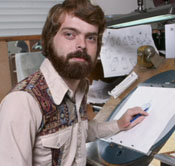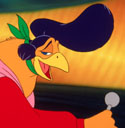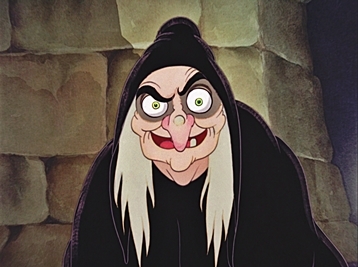
Donald Duck’s 50th Birthday. From Licensing Today magazine August 1984, “A special Rockefeller Plaza invitational birthday brunch in early June for Donald Duck’s 50th birthday included as part of the festivities, Donald presented with an honorary membership card from the Screen Actor’s Guild, and Ralph Bell, SAG’s first New York vice president making the presentation. After the birthday party, a 90 minute retrospective of the character’s shorts, The Donald Duck Film Festival opened at the Guild 50th Street Theater.”
The Donald Duck Film Festival ran in New York for two weeks and grossed over $27,000. It was a compilation of shorts like The Wise Little Hen, Don Donald, The Autograph Hound, etc. and excerpts from The Three Caballeros. One of the lobby cards featured an image from Der Fuehrer’s Face but the cartoon was not shown as part of the compilation. Macy’s, the “official New York department store” for Donald’s 50th birthday gave away 225 pairs of tickets for the festival.
The birthday celebration was part of a four day, fifteen city cross-country airplane tour aboard “Duck One, a Boeing 727 airplane provided to Walt Disney productions by P.S.A. Airlines”. The special plane was decorated with a sixteen foot Donald Duck decal and “Happy 50th Birthday” message along its side.
Wisdom of Chuck Jones. In fall 1984, animator and producer Chuck Jones told writer Michael Blowen, “I owe it all to a rabbit. He’s famous. I’m not. I’ve just followed in Bugs Bunny’s footsteps. I’m still amazed to be asked to be honored at Ivy League schools but, as I always say, you don’t have to deserve something to enjoy it. I graduated without distinction or the ability to draw.
 “You couldn’t exactly say that my career skyrocketed. But I finally found someone who didn’t recognize my lack of talent: producer Leon Schlesinger at Warner Brothers. He was in charge of the animation department and didn’t know anything about cartoons.
“You couldn’t exactly say that my career skyrocketed. But I finally found someone who didn’t recognize my lack of talent: producer Leon Schlesinger at Warner Brothers. He was in charge of the animation department and didn’t know anything about cartoons.
“One of the things that made those cartoons funny is that we didn’t cheat the audience by taking shortcuts. We used to spend hours trying to figure out how a fly lands on a ceiling. Every character had to express different movements. That was the key to physical cartoon comedy. We had no idea that people would still be watching them today and that I’d be honored by schools like Dartmouth. We were just having fun making fun and that was enough for us.
“Jay Ward’s literary sensibilities and brilliant sense of social satire didn’t require sophisticated animation. It just needed the sophisticated mind of Jay Ward. Walt Disney prepared the ground work for everyone.”
 Ron Clement on Little Mermaid. In a 1989 Minneapolis/St. Paul press event hyping the release of Disney’s The Little Mermaid (1989), director Ron Clements said, “We grew up on animation. When we became teenagers we grew away from it because it was…I don’t know…not cool. Now that our generation has children, we’re coming back to it. To me the fact that we are making a family movie does not mean it is just for children.
Ron Clement on Little Mermaid. In a 1989 Minneapolis/St. Paul press event hyping the release of Disney’s The Little Mermaid (1989), director Ron Clements said, “We grew up on animation. When we became teenagers we grew away from it because it was…I don’t know…not cool. Now that our generation has children, we’re coming back to it. To me the fact that we are making a family movie does not mean it is just for children.
“Animation does have that stigma. You know, drop the kids off at the theater and go see something else. With the legacy of the great Disney animated classics, we wanted to live up to them in terms of the visual look of the film. We wanted the film to remind people of those older films but still have a freshness to it.”
 Chanticleer. In the Los Angeles Times April 6, 1992 animator and producer Don Bluth talking about latest animated feature Rock-A-Doodle (1991) said, “(Chanticleer) is a story about someone who had lost faith in himself and starts to believe his whole life is a sham. I don’t cry easily but I was moved. Then I started thinking about Man of La Mancha. All this was more complicated than we could give to an audience of four year olds so we twisted it around and tried to tell it children – if you lose your self-confidence, you can’t do a thing. But if you have it, you can do anything. And we told it in a silly cartoon kind of way.”
Chanticleer. In the Los Angeles Times April 6, 1992 animator and producer Don Bluth talking about latest animated feature Rock-A-Doodle (1991) said, “(Chanticleer) is a story about someone who had lost faith in himself and starts to believe his whole life is a sham. I don’t cry easily but I was moved. Then I started thinking about Man of La Mancha. All this was more complicated than we could give to an audience of four year olds so we twisted it around and tried to tell it children – if you lose your self-confidence, you can’t do a thing. But if you have it, you can do anything. And we told it in a silly cartoon kind of way.”

Frank Thomas
“Today’s computers can generate cartoon actors with rich personalities and put them in story situations that achieve full audience involvement. However, the subtle pantomime, believable dialogue, appealing drawings and most of all that personal artistic statement may be beyond our reach in the mechanical area of electronic circuitry.”
Borrowing from Bluth. In the Los Angeles Times April 6, 1992 animator and producer Don Bluth talking about latest animated feature Rock-A-Doodle (1991) said, “I find little things that (Disney does now) reflecting things that we’ve done. They used to paint fire. We said, ‘let’s get color gels, light it from behind so it has a glow’. We did that on The Secret of NIMH (1982) for the first time, now all Disney fires are that way. They’ve adapted several techniques like that.”
Mark Henn. In the October 1986 issue of American Cinematrographer magazine, animator Mark Henn talked about Disney’s The Great Mouse Detective (1986): “As animators, we are the actors. We supply the emotional core to the character. It’s our job to take the various drawings and bring them to life. What ends up on the screen is at least 50% voice influenced. You could be going in one direction and once the actor gets a hold of it, he could take it in an entirely different one.”

The Snow White Witch. From Family Weekly magazine for October 27, 1979, actress Mariette Hartley who was starring as a witch in a live action special entitled The Halloween That Almost Wasn’t said, “The thought of witches terrified me. That’s because the first film I saw when I was four was Snow White and the Seven Dwarfs (1937). I was so frightened of the witch that for years afterward especially on Halloween, I had nightmares about witches. The one in Snow White was so graphic, so close to reality. I’ll never forget those long red fingernails.”


 Jim Korkis is an internationally respected animation historian who in recent years has devoted his attention to the many worlds of Disney. He was a columnist for a variety of animation magazines. With his former writing partner, John Cawley, he authored several animation related books including The Encyclopedia of Cartoon Superstars, How to Create Animation, Cartoon Confidential and Get Animated’s Animation Art Buyer’s Guide. He taught animation classes at the Disney Institute in Florida as well as instructing classes on acting and animation history for Disney Feature Animation: Florida.
Jim Korkis is an internationally respected animation historian who in recent years has devoted his attention to the many worlds of Disney. He was a columnist for a variety of animation magazines. With his former writing partner, John Cawley, he authored several animation related books including The Encyclopedia of Cartoon Superstars, How to Create Animation, Cartoon Confidential and Get Animated’s Animation Art Buyer’s Guide. He taught animation classes at the Disney Institute in Florida as well as instructing classes on acting and animation history for Disney Feature Animation: Florida.




















































Wish Disney would still do an elaborate anniversary celebration for Donald again like they do still do with Mickey. After all, Donald did eclipse Mickey in popularity by the late ’30’s.
Read the DD 50 book from my public library (that and Goofy Good Sport)
Back in ’84, I attended the Duck Festival at the Guild 50th Street theatre. I’d never seen most of the shorts in 35mm before, and they looked great on the big screen; the excerpts from CABALLEROS were a real highlight. I even got a free button. [The Guild 50th was a little jewel box of a theatre; it is greatly missed.]
I miss being able to see those shorts — and the great Disney features — on the big screen. The best of the Silly Symphonies and features like SNOW WHITE, PINOCCHIO and FANTASIA still warrant (and deserve) periodic theatrical reissue.
Never say never.
If you get a chance, son,
You may get to see some
At an animation con.
Of course, when Clarence Nash became Donald’s voice, he asked for credit and Walty declined, explained it would give away the illusion…..
That was really interesting about the glowing fire effect. It’s something the audience would never think about going into the movie the first time. It’s pretty clever.